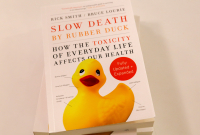Support strong Canadian climate journalism for 2025
Here’s a new one: U.S. President Donald Trump is trying to roll back another set of key environmental regulations in the United States.
While it could be easily mistaken for yet another example of our southern neighbours bearing the brunt of the current administration’s proclivity for deregulating industry at the expense of environmental protection, a closer look at this most recent chapter in Trump’s playbook reveals just how much his politics could have lasting impacts here in Canada.
The target this time is mercury emissions.
Mercury is a common byproduct of power plant activities and industrial mining processes. When ingested by humans, most commonly through the fish we eat, mercury poisoning can lead to a whole host of medical conditions that range from hair loss, muscle weakness or paralysis, organ damage, loss of senses, depression and even death.
To cut a long story short, through some selective mathematics on co-benefits, Trump and the new head of the Environmental Protection Agency (EPA), who happens to be a former coal lobbyist, are claiming that human health benefits of the current Obama-era regulations on mercury emissions are valued at $6 million. That’s down from the EPA's previously estimated figures of between $37 and $90 billion. Yes, you read that right.
Put simply, co-benefits are the ancillary effects of a set of regulations or practices that are also beneficial to the original cause: in this case, protecting public health. For example, in this instance, the explicit intent of the rules is to reduce mercury emissions. However, the measures implemented to achieve the original goal also resulted in reductions of other hazardous air pollutants (such as arsenic, benzene, cadmium, chlorine, formaldehyde, lead, manganese, nickel and selenium) which resulted in additional public health benefits. These are the co-benefits which can also be assigned a monetary value.
While the methods of calculation are complicated, it is clear that Trump is trying to use this new logic to significantly loosen the thresholds and guidelines on emissions of mercury and other particulates dangerous to human health—regulations that have been estimated to have saved Americans from 11,000 premature deaths, 4,700 heart attacks and 130,000 asthma attacks every year.
Impact on Canadians
Let’s not assume Canadians are immune from the fallout.
When mercury is emitted into the atmosphere from factories and coal plants, emissions pay no heed to international borders and travel where they please or, literally, wherever the wind blows. In fact, it was the international nature of atmospheric mercury deposition that inspired the biggest global effort to combat the problem of mercury pollution—the United Nations’ Minamata Convention on Mercury.
When it comes to our transboundary relationship with the United States, according to the Government of Canada, “the U.S. can be a significant source of smog and acid rain in certain regions of Canada.” Environment and Climate Change Canada states that 17 per cent of mercury deposited in Canada through the atmosphere comes from the United States. Long story short: when they increase their pollution, it affects us.
And increased mercury pollution would hit Canadians hard. Remember that many of our citizens, especially First Nations communities, depend on freshwater fish supplies (one of the primary sources of mercury poisoning in humans) for sustenance in a country with 20 per cent of the world’s total freshwater supplies.
Even so, there is hope.
The Canada-United States Air Quality Agreement, the Great Lakes Water Quality Agreement and the Minamata Convention have all set precedents for our countries’ bilateral action on tackling mercury and particulate pollution. We have put our heads together before, and we can do it again.
First, it is incumbent upon our government to pressure the Trump administration to reconsider its proposal for the EPA to disregard calculations of the co-benefits of mercury regulations when ascribing a monetary value to them. Our “special relationship” should accord us the privilege to challenge U.S. environmental policy and the space to collaborate with them to reformulate it to mutual benefit.
And we should also lead by example. It is high time Canada itself begins to consider co-benefits in its analysis of the value of much of its environmental policy, not just mercury emissions. For a long time this has been a limitation of our environmental regulation model and could benefit millions of Canadians’ lives.
Matthew McCandless is the Executive Director of IISD Experimental Lakes Area, an environmental research station headquartered in Winnipeg, and an expert in freshwater and wastewater issues.







Comments